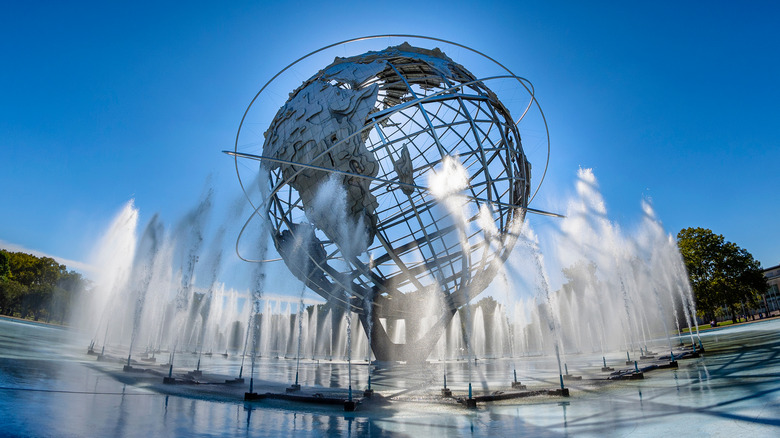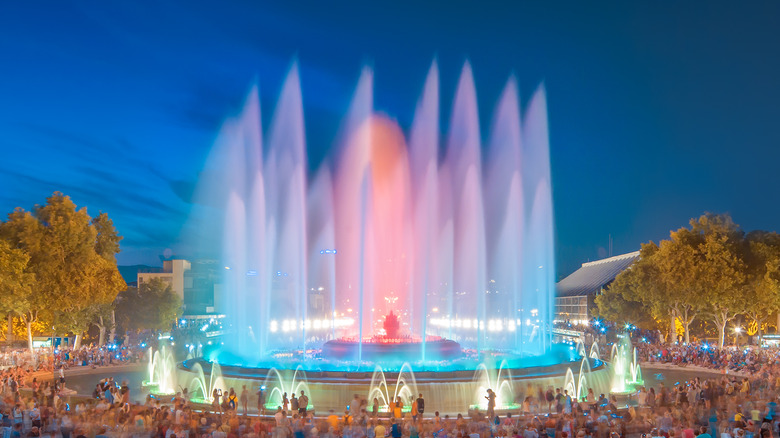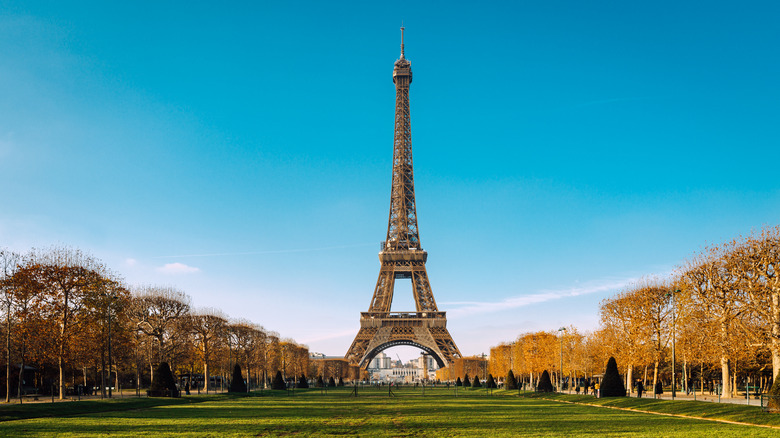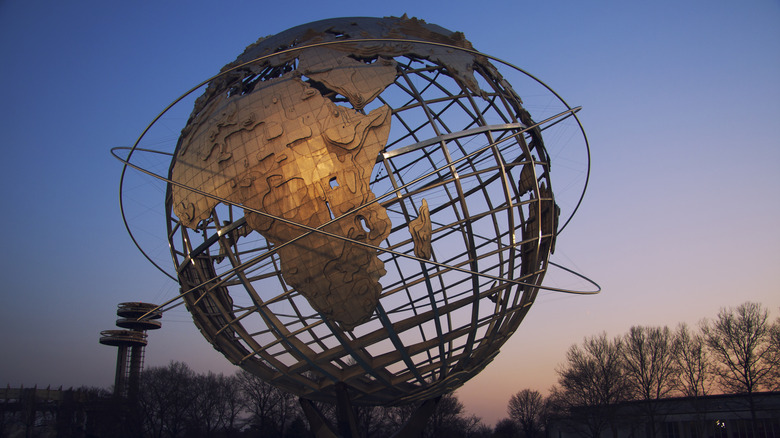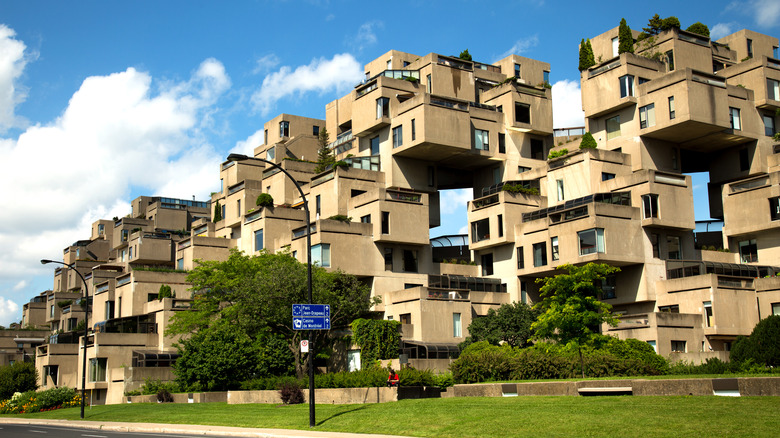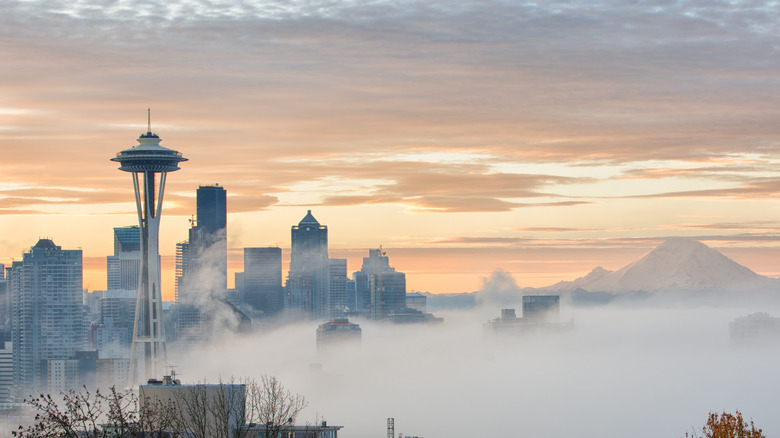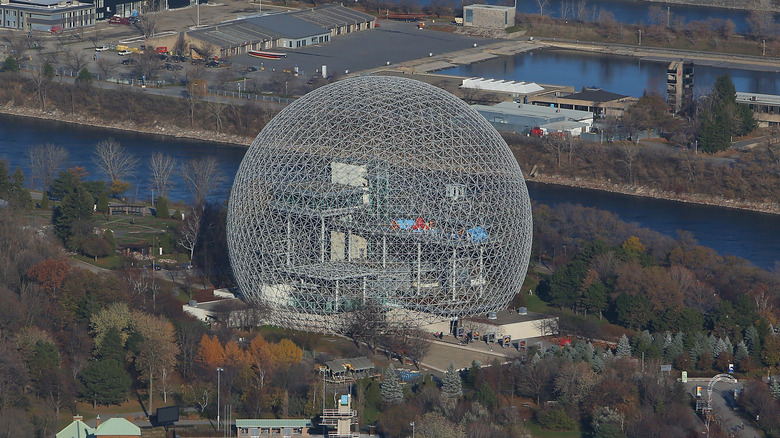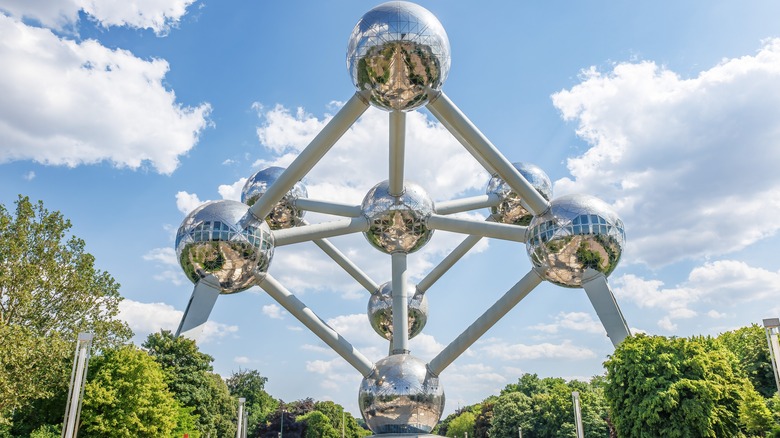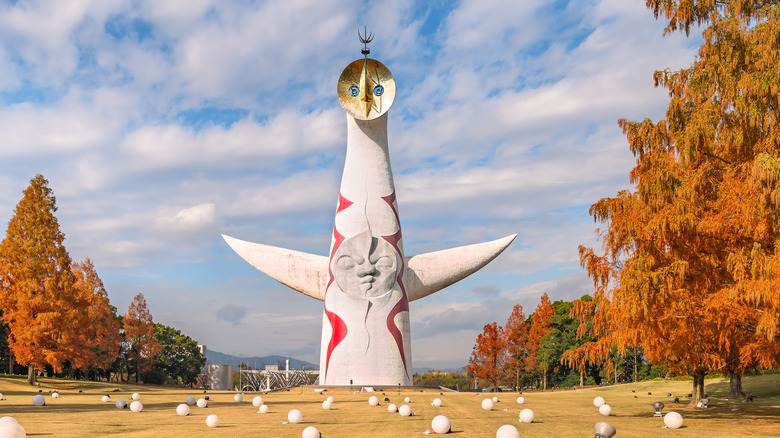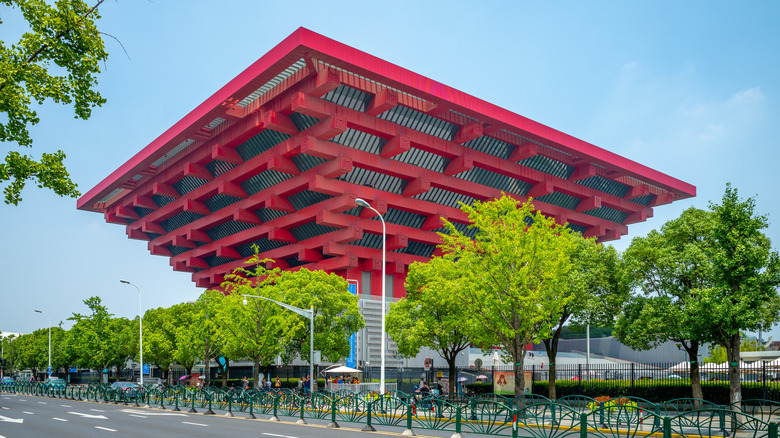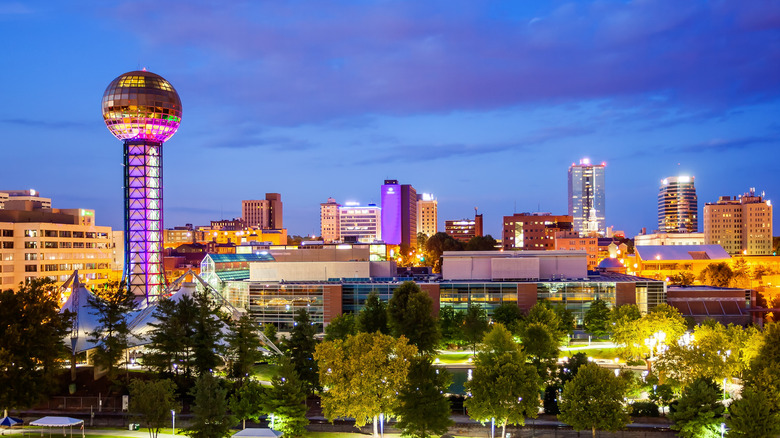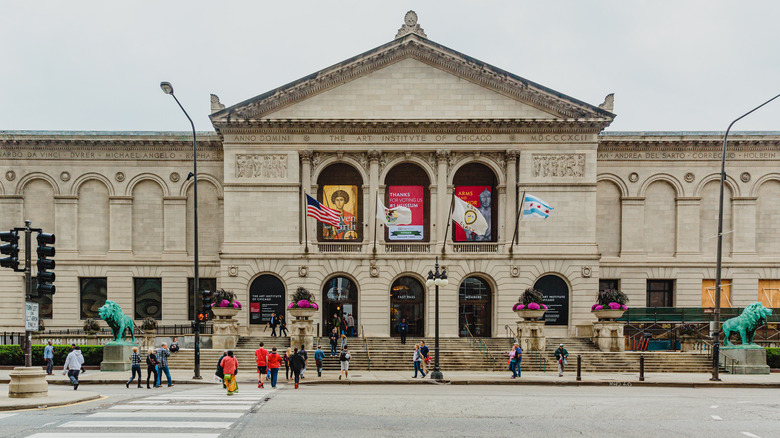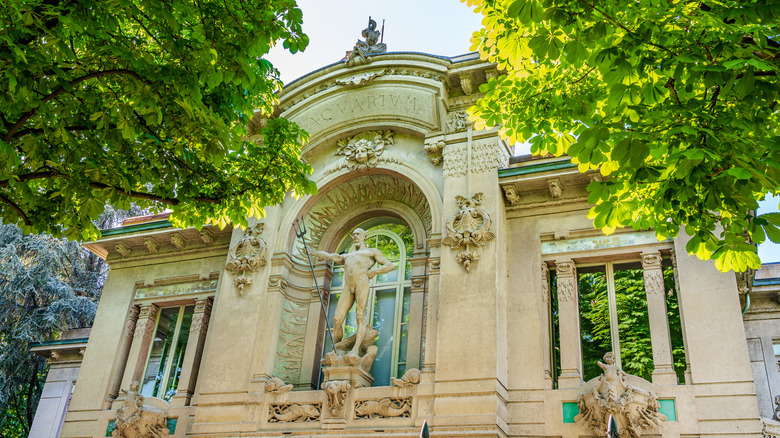12 Structures Built For The World's Fair That Still Exist
When countries want to show off, they hold a world's fair. Also known as international expositions, World Expos, or simply expos, these are gatherings of nations to display technological progress, cutting-edge concepts, and cultural achievement. In essence, these expos show the significant accomplishments of humanity and hope for the future, not just which country has the biggest pumpkin. These international shows started, according to the Bureau International des Expositions (the organization responsible for coordinating World Expos), at London's Great Exhibition in 1851, although other sources, such as "The Routledge Handbook of Museums, Heritage, and Death," attribute the first world's fair to Prague in 1791.
A country's presence at a world's fair is based at its pavilion. A world's fair pavilion goes far beyond hammering in some stakes and throwing up a tent. World's fair structures sometimes become a permanent part of a host city's cultural and physical landscape. More than anything else, these structures are a living memory of the fair and a snapshot of the attitudes, perceptions, and hopes of the people who made them. For example, many mid-20th-century structures have outer-space themes, showing people's aspirations concerning space exploration. Other buildings are experiments to address housing problems, reflecting concerns and issues of the time. Still others are timeless and make grand pronouncements about the future of humanity. Let's look at some of the famous world's fair structures that still exist today.
The Magic Fountain of Montjuïc, Barcelona
Barcelona in Catalonia, Spain, delights tourists' eyes, from the heights of the cathedral Sagrada Família to the fantastical architecture of Park Güell. Yet, the most delightful to all human senses is the Magic Fountain of Montjuïc, adjacent to the Museum Nacional. This landmark was the dreamchild of Carles Buigas, who wanted to provide an exceptional sensory experience to the attendees of the city's 1929 International Exposition.
So elaborate is the design of the fountain that it took 3,000 workers a year to put the whole thing together. The result is an over-the-top marvel that features over 4,500 lights that blaze through the water in different colors. Today, the water is coordinated to music that ranges from classical compositions to popular hits. The Magic Fountain even plays music by Queen.
The fountain, being nearly a century old, is a little long in the tooth, but it has undergone several renovations. The latest updates, according to the fountain's official site, include a 3D choreography generator to help create and preview shows without wasting water and a retrofit to RGB LED technology. These upgrades have helped turn this world's fair wonder into a site that takes into account the sustainability concerns of the 21st century.
Eiffel Tower, Paris
To most people, the Eiffel Tower is to Paris what beurre is to a baguette. Thus, it may be surprising to many that this most Parisian of Paris landmarks is a relatively new feature to the city. The committee organizing the City of Light's International Exposition for 1889 wanted a distinctive piece of architecture to commemorate the event, which was also the centennial of the French Revolution. Dozens of designs were considered and passed upon until the committee accepted a proposal from the engineer Gustave Eiffel.
The Eiffel Tower was radical in design for its time, and there were numerous objections to its planned construction because those with certain aesthetic sensibilities thought it would forever stain the Parisian skyline. Perhaps for this reason, construction moved along quickly, taking only two years and up to 300 people to build its iron, open-lattice structure.
The result was a masterpiece of design, which, at 984 feet in height, became the tallest building in the world at that time, marveling exposition guests who passed under it to enter the fair. Paris' International Exposition was one of the most successful world's fairs so far, being one of those rare ones that made a profit. The Eiffel Tower was supposed to be temporary, but it so awed people that it transcended the fair and became a permanent, iconic landmark synonymous with France.
Unisphere, New York City
If you happen to be heading to the borough of Queens in New York City, perhaps to catch a Mets game or watch a match at the U.S. Tennis Center, you may want to swing by Flushing Meadows Corona Park, home to the gawk-worthiest globe known to humankind. The aluminum and stainless steel Unisphere, designed by Gilmore D. Clarke for the New York World's Fair of 1964 to 1965, was, at the time, the world's largest globe, with a 120-foot diameter and weighing 350 tons. It was meant to reflect the vision of the fair: "Peace Through Understanding."
The fair was promoted by the urban builder Robert Moses, who wanted something monumental and future-facing. To this end, the globe is ringed with circles representing the early flights of space explorers Yuri Gagarin and John Glenn. Moses figured such a staggering statement would guarantee that the park would eventually be renamed in his honor. However, the New York World's Fair was a financial flop, and the Unisphere became a failed symbol of urban development. In the decades since, the great globe fell into disrepair. Then, in the 1990s, conservation efforts began, which have primarily stabilized this monument to America's optimistic vision of itself and the world in the age of the Space Race.
Habitat 67, Montreal
Montreal's Expo in 1967 showcased midcentury dreams, and Habitat 67 was the most surreal of those fantasies, looking today like a hallucination out of the mind of a 4-year-old playing too much "Minecraft." This modernist housing unit consists of separate prefabricated blocks stacked in a helter-skelter way to provide open areas and green space; each unit has access to a roof garden. It overwhelms the eyes in its seemingly asymmetrical flow.
Habitat 67's concept came from the imagination of the Canadian-Israeli architect Moshe Safdie, who first toyed with the idea while still at school as a way to solve modern housing problems. In 1967, suburban sprawl was on the rise while the block units of urban apartment complexes were dreary and unconnected to light and nature. Habitat 67 was meant to remedy this problem and provide the benefits of suburban openness within the context of urban life.
Habitat 67 was for more than display; people did (and do) live there. While some residents love the unique features of the site and its strong feeling of community, others have left, citing mold caused by water in the concrete and other concerns. Habitat 67's architecture has yet to catch on elsewhere, but the structure has been given heritage status by the Quebec government and stands as a symbol of the utopian dreams of the 1960s.
Space Needle, Seattle
The idea for the most iconic landmark in Seattle stemmed from the mind of Seattle hotel magnate Edward E. Carlson, who was one of the primary organizers of 1962's Century 21 Exposition. He visited a radio tower in Stuttgart, Germany, which featured a restaurant at the top, and thus became inspired to bring something similar to Seattle. He dubbed his concept the Space Needle.
The design of the Space Needle went through multiple iterations. Architect John Graham, Jr. added the UFO-shaped observatory on top, and Victor Steinbrueck added the hourglass shape of the tower. Work started in 1961 in an immense construction effort, which included a foundation poured by 467 cement trucks into a 120-foot-wide, 30-foot-deep hole over the course of an entire day. The result was a 605-foot-tall icon that provides a 360-degree view of the surrounding region from downtown Seattle to the Cascades. At the time, it was the tallest human-made structure west of the Mississippi.
The Space Needle has been a lasting success for Seattle, seeing millions of visitors annually. In 2018, a $100 million renovation was completed, which installed a glass-floor observation deck. This allowed visitors to see, for the first time, the gears that rotate the floor, leading to the further impression of floating on a ride up to the cosmos.
Biosphere, Montreal
World's fairs are platforms for visions of the future, and one of the most outstanding is Buckminster Fuller's Biosphere in Montreal, Canada. This conglomeration of tetrahedrons built for the city's Expo in 1967 cries out "the future," but unlike other futuristic-type buildings, Fuller went beyond just providing a Jetsons-esque facade. His goal was to improve the human way of life through the geodesic dome.
Fuller wanted to make homes safer, more comfortable, and sustainable. According to the Buckminster Fuller Institute, his geodesic dome design created a transportable, lightweight type of housing that was more environmentally efficient than typical post-and-beam homes that relied on basic geometry. A geodesic dome encloses lots of area in the most efficient way possible, reducing costs. The Biosphere, which became the American pavilion at Expo 67, was Fuller's showcasing of this startling habitat for the future.
Fuller's geodesic domes have yet to become mainstream, partly because of aesthetic tastes and partly because the spherical design means valuable corner space would be lost in a city's angular urbanscape. This has made Montreal's Biosphere even more unusual as a site to visit. Today, the Biosphere is home to an environmental museum.
Atomium, Brussels
All world's fairs like to go big, with massive, attention-getting structures. But planners went big and small for the 1958 International Exhibition in Brussels, Belgium, by building the world's biggest atom. The Atomium, according to John Graham-Cumming in "The Geek Atlas," is an over 300-foot marker of the mid-century belief in the development of atomic science and how Belgium was at the cutting edge of modern technology.
The atom represented in the Atomium is iron, and each sphere houses different attractions such as exhibition spaces, a restaurant, and a viewing platform. These are all connected via walkways between the spheres. The edifice was so successful that even though it was meant to be a temporary structure, it was kept on indefinitely.
Although Atomium represents iron, it was initially made of aluminum, and when it was renovated between 2004 and 2006, it was replaced by stainless steel. Still, this non-iron iron building is one of Belgium's most unique monuments.
Tower of the Sun, Suita
For its 1970 Osaka Expo, Japan built a tower so strange that it might have doubled as a monster in a Godzilla flick or a Power Rangers episode (albeit cuter). The Tower of the Sun is a 230-foot triangular tower with two horn-like arms or ears and three enigmatic faces. Artist Tarō Okamoto designed the building to represent the past, present, and future through the three faces. Inside was erected a sculpture called the Tree of Life, one of the expo's centerpieces.
After the expo closed, the Tower of the Sun was not demolished but rather left to its own devices. Weathering took a heavy toll in just a few years. However, in the 2010's, the Tower underwent a large-scale renovation (per the Tara Okamoto Memorial Museum) so that in 2018, the interior of the Tower was open to the public for the first time in decades. Today, the Tower of the Sun is a unique museum and the centerpiece of a public park.
China Art Palace, Shanghai
If you feel like spending a week in a museum, then you should head over to Shanghai and visit the China Art Palace. The sprawling building contains five levels of Chinese modern art, equating to over 688,000 square feet of exhibition space. What makes the China Art Palace distinctive is its architecture, which incorporates the design of a traditional Chinese pagoda painted fire-engine red.
The China Art Palace came about as a retooling of China's pavilion from its 2010 World Expo when Shanghai set a long-range goal of becoming a cultural capital on par with international cities such as New York and Paris. The Expo was partly an attempt by the country to reassert itself culturally since the 20th-century twin traumas of the Chinese Civil War and Cultural Revolution had gutted Chinese society and culture. The challenge was to draw visitors, especially among Chinese nationals who initially saw no practical value in modern art. For example, NPR reported in 2013 that even though the new museum sought to engage students with workshops and field trips, schools did not see the value of adding those excursions to the curriculum when their sole focus was on getting students into college.
Today, the museum features one of the world's largest collections of modern Chinese art as well as special shows that bring in works from international artists.
Sunsphere, Knoxville
World's fairs have a way of bringing the celestial to Earth, and the 1982 World's Fair in Knoxville, Tennessee, was no exception. According to Martha Rose Woodward's "Knoxville's 1982 World's Fair," the idea of the Sunsphere was the brainchild of architect Hubert Bebb, who conceived a giant, nonsolar orb situated on terra firma. He thought it would make for a great restaurant. However, Jake Butcher, one of the main organizers of the fair, took it to a whole new level and thought it would be an awesome topper to a tower that could provide a panoramic view of downtown Knoxville against the background of the Smoky Mountains. The final design was by architect William Denton, who touched on the fair's theme of "Energy Turns the World" by making the sphere into a sun on Earth.
The result was a magnificent 192-foot tower with a golden 74-foot sphere bedecked with 360 windows. When one looks at the structure, it may appear lopsided because of its engorged top. However, there is little fear of it toppling since the foundation contains so much concrete that it is heavier than the orb and tower combined — Woodward compares its structure to a standard house lamp, albeit a touch bigger. Today, the city of Knoxville owns the Sunsphere, which has drawn tens of thousands of visitors per year and notably even more pigeons and starlings.
Art Institute of Chicago
Chicago's 1893 World's Fair, called the World's Columbian Exposition, was opened to commemorate four centuries of progress since the voyages of Christopher Columbus. World's fairs in the 19th century were highly popular, but not necessarily economically successful, events, drawing in millions of people. In fact, the National Archives relates how one-third of the population of the United States visited the 1893 event.
Chicago was adorned with an array of buildings especially crafted for the Exposition. Of these, only two still survive: the Palace of Fine Arts (today's Museum of Science and Industry) and the World's Congress Auxiliary Building (today's Art Institute of Chicago). This latter structure was built in the Beaux Arts style and became internationally known for its world-class fine art collection. Subsequent expansions of the original building have made it nearly one million square feet, allowing it to contain about 300,000 works of art, making it the second-largest art museum in the United States (after the Metropolitan Museum of Art in New York).
Civic Aquarium, Milan
An aquarium might be one of the most surprising world's fair structures still existing. The Civic Aquarium in Milan was built for the city's 1906 Expo and is the last building standing from it. Its Arts Nouveau style, designed by Sebastiano Locati, is eye-catching, adorned outside and throughout with numerous statues of aquatic life. Perhaps the boldest statue is the trident-wielding Neptune standing guard over the structure.
The Civic Aquarium is home to about 36 tanks containing some 100 species, mainly Mediterranean fishes and invertebrates, although it does have some rare species of tropical fish. It also contains a library that collects some rare works on aquatic life. By comparison, the central, 200,000-gallon tank at the New England Aquarium in Boston has 100 species in it alone. Still, the Civic Aquarium is an excellent site for learning about local sea fauna in a truly remarkable building. Besides, admission is free.
